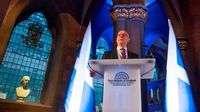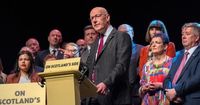Scottish politics has rarely been short on drama, but the past eighteen months have delivered a particularly dizzying ride. Just a year ago, pundits were writing off the Scottish National Party (SNP), battered by internal strife and an electoral rout that saw their Westminster MPs plummet from 48 to a mere 9. Yet, as October 2025 unfolds, First Minister John Swinney stands on the cusp of what many are calling a remarkable political resurrection—one that could see the SNP claim a fifth consecutive term in government and reignite the country’s independence debate.
John Swinney’s journey to the top job was anything but planned. According to the Daily Record, Swinney had been eyeing a quiet retirement in 2026, content to watch his son play hockey. Instead, he was thrust into leadership after Humza Yousaf’s ill-fated tenure ended abruptly, lasting just one year, one month, and eight days. Swinney inherited a party in chaos: headquarters were described as “fundamentally broken,” with one close ally recounting, “The party was struggling to do the basics like put out a manifesto.” The SNP’s internal analysis at the time predicted a humiliating return of just 36 MSPs at the next Scottish Parliament poll.
Yet, Swinney’s steady hand and pragmatic focus have reversed the party’s fortunes. By the start of 2025, those seat projections had risen to 54, and now, as the SNP gathers for its annual conference in Aberdeen, the figure sits at 60—enough for a majority. Polling puts the SNP at 37%, ahead of Scottish Labour and within striking distance of an outright win in the May 2026 Holyrood election. Swinney’s formula for revival? “I’ve focused the government on addressing the public’s concerns and priorities,” he told ITV News. “The real issues that matter in people’s lives, whether that's about improving the state of the economy, about improving our public services, making sure that we succeed in our efforts to deliver the transition to net zero or about eradicating child poverty.”
But Swinney’s resurgence is set against a backdrop of deep voter volatility. Many analysts, as reported by the Daily Record, attribute the SNP’s poll lead less to their own performance in government—still widely criticized—and more to public disillusionment with Keir Starmer’s UK Labour administration. Swinney himself has not shied away from such attacks, telling ITV News that he doubts Starmer will survive as Labour leader until the next UK general election. “It’s almost scarcely believable, the sense of disappointment that has taken place, because the first act of a Labour government was to remove the winter fuel payments from pensioners and then almost just unbelievable decision. And it’s really kind of gone on ever since. I think overwhelming the sense that I detect in the population is of real disappointment in the Prime Minister and the Labour government.”
The rise of the Reform party, led by Nigel Farage, presents yet another twist. Reform finished a close third behind the SNP at the Hamilton by-election this summer, and polling suggests they’ll perform strongly in May. Swinney blames Starmer for “pandering to the rise of Reform,” arguing, “He’s not confronted the absolute fallacies that lie at the heart of what Nigel Farage is talking about.” The First Minister’s own vision is the antithesis of Farage’s: pro-immigration, pro-EU, and staunchly pro-independence.
This week, Swinney published yet another white paper—titled "A Fresh Start With Independence"—outlining his blueprint for a breakaway Scotland. The plan, however, has drawn skepticism. Critics, including economists cited by ITV News, argue the document offers optimism in place of specifics, particularly over currency. Swinney’s proposal would see Scotland continue using the pound sterling until a new Scottish currency, backed by a central bank, could be established. But how long would that transition take? “Well, it would depend on the economic conditions and circumstances,” Swinney admitted, declining to offer a definitive timeline.
This uncertainty is not academic: under Swinney’s plan, Scotland would be ineligible to join the European Union while using a non-member’s currency, potentially leaving the country isolated and exposed to economic turbulence. When pressed about the risks, especially for families already struggling with poverty, Swinney maintained, “In that particular scenario, we will be doing everything we can to continue the good work to reduce child poverty.” He insists the current UK system is dragging Scotland down, saying, “Living standards have stagnated in Scotland.”
Yet, Swinney’s independence strategy faces internal resistance. As reported by the Daily Mail, today’s conference in Aberdeen is set for a showdown with party activists. Swinney wants the SNP to treat an outright majority at Holyrood as a mandate for a second referendum, mirroring the party’s 2011 success. But a significant faction, backed by nine branches, prefers a lower bar: treating the May 2026 election as a ‘de facto referendum’—if all separatist parties combined win the most list votes, they would claim a mandate for independence and the formation of a ‘provisional government.’ Swinney has dismissed this approach, arguing, “I don’t think it would work.”
The conference is also marked by poignant timing: it coincides with the first anniversary of former First Minister Alex Salmond’s death, with Nicola Sturgeon—herself a divisive figure—returning to speak at a fringe event about her much-criticized plan to help children in care. Sturgeon recently encouraged independence supporters to “keep the faith,” predicting the union would end sooner than many expect.
The opposition, meanwhile, is sharpening its knives. Scottish Labour leader Anas Sarwar has accused the SNP of being “desperately out of touch squabbling over independence while services across Scotland are at breaking point.” He added, “We can’t risk a third decade of this tired and incompetent government.” Sarwar’s allies believe he could become First Minister with as few as 38 Labour MSPs, and Labour is preparing its most well-resourced campaign in the history of devolution.
Beyond domestic politics, Swinney has made headlines for his international overtures. In July, he met with former US President Donald Trump during a visit to Scotland. Trump, it turns out, changed the dinner seating plan to sit next to Swinney—a move the First Minister used to press Trump on the Israel-Gaza conflict. “I thought that all those people that tried to manoeuvre things around about me had sent me to the bottom of the table, but apparently it was that President Trump had asked me to sit beside him,” Swinney told ITV News. “I had about an hour and a half, one to one with President Trump at the dinner table… But I also used the time with President Trump to say to him that I thought he was the only person in the world that could perhaps say to the Israeli Prime Minister that had to change what he was doing and stop the genocide in Gaza. And I’m glad I raised that with President Trump because I could look at people now in Scotland to say that I’d used every opportunity to try to help the people of Gaza and I welcome the steps that have now been taken.”
With seven months until the Holyrood election, Scotland faces a contest that is anything but settled. The SNP’s revival under Swinney is real but fragile, the independence movement is as divided as ever, and the stakes—for Scotland’s future in the UK and beyond—could hardly be higher.


